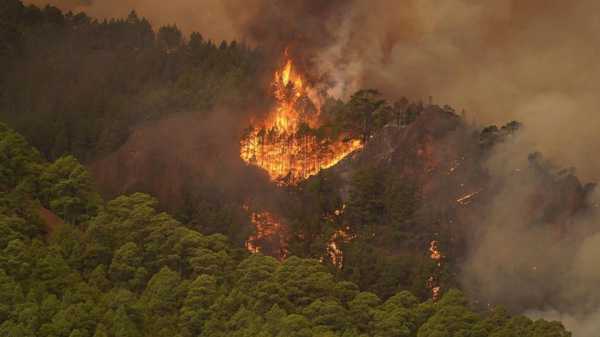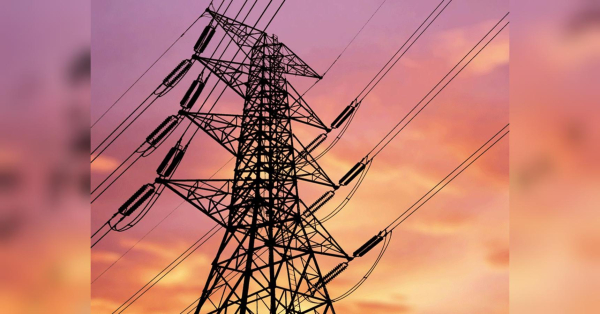
SANTA CRUZ DE TENERIFE, Canary Islands — Firefighters in Spain's Canary Islands are battling dense smoke and high temperatures to try to control the worst wildfire in decades on the main tourist island of Tenerife, officials said Friday.
The fire started late Tuesday in the north of the island and has forced authorities in eight municipalities to order the evacuation of more than 4,500 people and the confinement of thousands more. Confinement means residents are strongly advised to stay indoors with windows closed.
No injuries have been reported so far.
The fire is located in a steep and craggy mountain area with pine trees, with several municipalities on its flanks, including El Rosario, Arafo and Candelaria to the east, and La Orotava to the west. Access for firefighters is extremely difficult.
Television images and videos posted on social media have showed the flames coming down a hill close to houses in small neighborhoods and a massive cloud of smoke rising from the area.
Candelaria mayor María Concepción Brito Núñez told Spanish National Television that firefighters complained that the water being dumped on the flames was evaporating before hitting the ground because of the high temperatures.
The army’s Military Emergency Unit said that dense clouds of smoke were impairing visibility for firefighters and preventing many water-carrying aircraft from getting close.
Army Capt. Rafael San José told Spanish National Television that some progress had been made overnight in stopping the fire's spread but that rising temperatures during the day would increase difficulties.
Favorable conditions Friday in the town of El Rosario prompted authorities to lift the confinement call for half of the 3,800 residents there.
The Canary Islands have been in drought for most of the past few years, just like most of mainland Spain. The islands have recorded below-average rainfall in recent years, because of changing weather patterns impacted by climate change.
The fire is said to have scorched more than 3,200 hectares, or 7,900 acres.
Regional President Fernando Clavijo said Friday’s efforts would be crucial to containing the fire. The air quality in several municipalities remains hazardous and vulnerable people are advised not to leave their homes, he said.
The north of the island was forecast to have a maximum temperature of 30 degrees Celsius (84 F) Friday with light winds, (20 kph/12 mph) but temperatures were set to rise over the weekend.
Regional government meteorologist Vicky Palma told reporters that temperatures of up to 34 degrees Celsius (93 F) will be reached Saturday in the wildfire area, and temperatures will continue to rise on Monday and Tuesday.
The flames cover a perimeter of 40 kilometers (25 miles) encircling some 4,000 hectares (10,000 acres) of land. Nearly 600 firefighters and Spanish army soldiers are in the area, which is in the northeast of the island, some 20 kilometers (12 miles) away from its main town, Santa Cruz.
Tenerife is one of Europe's main tourist destinations. Its tourism office stressed Thursday that the most important tourist areas are far from the fire. Business continues as usual in accommodation establishments, beaches and other tourist sites near the coast and in the midlands, the office said.
But access to the Teide National Park, the most important tourist attraction in Tenerife after the beaches, was closed Thursday evening and all tourist facilities around the Teide volcano area, including accommodation, were to be evacuated.
Clavijo claimed the fire was the worst in 40 years. He said the combination of extreme temperatures and the fire had turned the area into a virtual oven.
The seven-island archipelago is located off the northwest coast of Africa and southwest of mainland Spain.
More than 2,000 people were evacuated in a wildfire on the nearby La Palma island last month that affected some 4,500 hectares (11,000 acres).
According to the latest figures from the European Forest Fire Information System, Spain heads the list of EU countries affected by wildfires so far this years, with 75,000 hectares ( 185,000 acres) burned, ahead of Italy and Greece.
Spain accounted for almost 40% of the nearly 800,00 hectares (2 million acres) burned in the European Union in 2022, the EU agency said.
____
Ciarán Giles in Madrid contributed to this story. David Brunat contributed from Barcelona.
____
Follow all AP stories on climate change at https://apnews.com/hub/climate-and-environment contribute to this story
Sourse: abcnews.go.com






